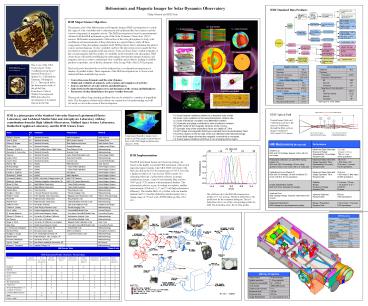HMI Major Science Objectives - PowerPoint PPT Presentation
Title:
HMI Major Science Objectives
Description:
... Space Science Laboratory, Rutherford Appleton Laboratory, and the HMI Science Team ... Precursors of solar disturbances for space-weather forecasts. ... – PowerPoint PPT presentation
Number of Views:38
Avg rating:3.0/5.0
Title: HMI Major Science Objectives
1
Helioseismic and Magnetic Imager for Solar
Dynamics Observatory
Philip Scherrer and HMI Team
HMI Major Science Objectives
1.B Solar Dynamo
- The primary goal of the Helioseismic and Magnetic
Imager (HMI) investigation is to study the origin
of solar variability and to characterize and
understand the Suns interior and the various
components of magnetic activity. The HMI
investigation is based on measurements obtained
with the HMI instrument as part of the Solar
Dynamics Observatory (SDO) mission. HMI makes
measurements of the motion of the solar
photosphere to study solar oscillations and
measurements of the polarization in a spectral
line to study all three components of the
photospheric magnetic field. HMI produces data to
determine the interior sources and mechanisms of
solar variability and how the physical processes
inside the Sun are related to surface magnetic
field and activity. It also produces data to
enable estimates of the coronal magnetic field
for studies of variability in the extended solar
atmosphere. HMI observations will enable
establishing the relationships between the
internal dynamics and magnetic activity in order
to understand solar variability and its effects,
leading to reliable predictive capability, one of
the key elements of the Living With a Star (LWS)
program. - The broad goals described above will be addressed
in a coordinated investigation in a number of
parallel studies. These segments of the HMI
investigation are to observe and understand these
interlinked processes - Convection-zone dynamics and the solar dynamo
- Origin and evolution of sunspots, active
regions and complexes of activity - Sources and drivers of solar activity and
disturbances - Links between the internal processes and
dynamics of the corona and heliosphere - Precursors of solar disturbances for
space-weather forecasts. - These goals address long-standing problems that
can be studied by a number of immediate tasks.
The description of these tasks reflects our
current level of understanding and will obviously
evolve in the course of the investigation.
1.C Global Circulation
1.J Sunspot Dynamics
1.I Magnetic Connectivity
1.A Interior Structure
1.D Irradiance Sources
1.E Coronal Magnetic Field
1.H Far-side Imaging
1.F Solar Subsurface Weather
1.G Magnetic Stresses
HMI Optical Path Normal Image Mode and
Calibration mode have the same ray distribution
through the filter sections. Image is matched to
40962-pixel CCD camera
HMI is a joint project of the Stanford University
Hansen Experimental Physics Laboratory and
Lockheed-Martin Solar and Astrophysics Laboratory
with key contributions from the High Altitude
Observatory, Mullard Space Science Laboratory,
Rutherford Appleton Laboratory, and the HMI
Science Team
1.A) Sound speed variations relative to a
standard solar model. 1.B) Solar cycle variations
in the sub-photospheric rotation rate. 1.C) Solar
meridional circulation and differential
rotation. 1.D) Sunspots and plage contribute to
solar irradiance variation. 1.E) MHD model of
the magnetic structure of the corona. 1.F)
Synoptic map of the subsurface flows at a depth
of 7 Mm. 1.G) EIT image and magnetic field lines
computed from the photospheric field. 1.H) Active
regions on the far side of the sun detected with
helioseismology. 1.I) Vector field image showing
the magnetic connectivity in sunspots. 1.J) Sound
speed variations and flows in an emerging active
region.
Sound-speed beneath a sunspot (red positive and
blue negative perturbations) from SOHO/MDI
high-resolution data (June 18, 1998).
HMI Implementation The HMI instrument design and
observing strategy are based on the highly
successful MDI instrument, with several important
improvements. Like MDI, HMI will observe the full
solar disk in the Ni I absorption line at 6768 Å,
but with a higher resolution of 1 arc-second. HMI
consists of a refracting telescope, a
polarization selector, an image stabilization
system, a narrow band tunable filter and two
4096² pixel CCD cameras with mechanical shutters.
The polarization selector, a pair of rotating
waveplates, enables measurement of Stokes I, Q, U
and V with high polarimetric efficiency. The
tunable filter, a Lyot filter with one tunable
element and two tunable Michelson
interferometers, has a tuning range of 750 mÅ and
a FWHM filter profile of 84 mÅ.
The solid lines show the HMI filter transmission
profiles at 75 mÅ spacing. The black dashed line
is the profile used for the continuum filtergram.
The red dashed line shows one of the
corresponding profiles for MDI. The dotted line
shows the Ni I line profile.































